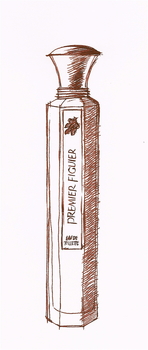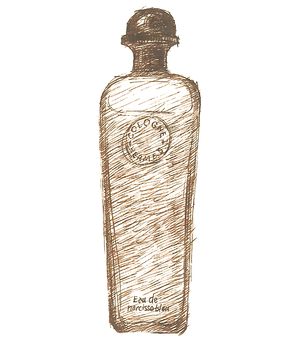Tagged With ‘Premier Figuier’
L’Artisan Parfumeur
Premier Figuier
20 October, 2017
 L’Artisan Parfumeur began life in as a small independent brand back in 1979, when Jean Laporte opened his first boutique on Paris’s Rue de Grenelle. Laporte (who had already founded Sisley Paris in 1972) trained as a chemist but had a keen nose, and his first commercial fragrance, Mure et Musc, really captured the spirit of its time. A sweet, slightly hippyish scent, combining blackberries and musk, it established his name and became a big seller in the newly emerging niche-perfume market.
L’Artisan Parfumeur began life in as a small independent brand back in 1979, when Jean Laporte opened his first boutique on Paris’s Rue de Grenelle. Laporte (who had already founded Sisley Paris in 1972) trained as a chemist but had a keen nose, and his first commercial fragrance, Mure et Musc, really captured the spirit of its time. A sweet, slightly hippyish scent, combining blackberries and musk, it established his name and became a big seller in the newly emerging niche-perfume market.
Jean Laporte sold up in 1982 and went on to found the smaller but highly regarded Maitre Parfumeur et Gantier, but L’Artisan Parfumeur continued to expand, fuelled by a run of ground-breaking fragrances. After a long, slow drift into the perfume wilderness, the brand was bought by the Spanish giant Puig, which has given it a much-needed makeover, though it can hardly be regarded as a small independent any more.
Premier Figuier, created by Olivia Giacobetti and released in 1994, very much lives up to its name, in that it was the first perfume to really smell of figs (the fruit but more especially the leaves). I love their scent, which is intensely green and slightly earthy and somehow very sexy, which surely has something to do with their association with baking Mediterranean heat.
Premier Figuier captures that scent perfectly, managing to smell both fresh and slightly sultry at the same time; it also lasts for most of the day. For many years it has been among my favourite fragrances, but not long ago someone pointed out that, like some other perfumes, it has the odd property of also smelling weirdly similar to something else – in this case coconut, which is a scent I’ve never much liked.
As a result, now I get the olfactory equivalent of double vision every time I wear it, which (much to my regret) has slightly lessened its appeal. But don’t let that put you off: if you can ignore my spoiler alert it’s well worth trying.
Hermès
Eau de Narcisse Bleu
10 October, 2014
 Pretty much everyone I know loves Hermès’ deliciously fresh and zingy Eau d’Orange Verte, so when Eau de Narcisse Bleu (literally ‘blue narcissus water’) was launched in 2013 it had a tough act to follow. As I’ve never seen a blue narcissus / daffodil, I think it’s safe to say that this perfume has an element of fantasy about it, and as a smell, too, it’s perhaps rather more complex and a little less instantly accessible than its predecessor. But give it a little time and I think it’ll grow on you.
Pretty much everyone I know loves Hermès’ deliciously fresh and zingy Eau d’Orange Verte, so when Eau de Narcisse Bleu (literally ‘blue narcissus water’) was launched in 2013 it had a tough act to follow. As I’ve never seen a blue narcissus / daffodil, I think it’s safe to say that this perfume has an element of fantasy about it, and as a smell, too, it’s perhaps rather more complex and a little less instantly accessible than its predecessor. But give it a little time and I think it’ll grow on you.
Eau de Narcisse Bleu may not have the euphoric mood-lifting freshness of Eau d’Orange Verte, but it has a gentle softness that, once you’ve smelled it for a while, is extremely appealing in its own right. It does have the faint sweetness of real daffodil flowers (try sticking your nose in one on a sunny day next March and you’ll see what I mean), but what narcissus extract smells of most, rather unexpectedly, is fresh hay. *
Now, I have nothing against smelling of hay, which is a lovely scent in its own right, but what Hermès’ much-mythologised perfumer, Jean-Claude Ellena, has done is blended the smell of hay with a whole raft of subtly complementary fragrances. Most of them are quite ‘green’ – that is, they smell fresh and natural, like grass and leaves, but not especially sweet or flower-like.
To me it has a slight but definite scent of fig-leaves, which for anyone who loves L’Artisan Parfumeur’s wonderful Premier Figuier as much as I do can only be a good thing. Whether this figginess is (excuse the pun) a figment of my imagination I’m not sure, but among the other ingredients that Ellena lists is galbanum, which is extracted from the root of a wild Iranian plant that looks a bit like fennel or cow-parsley, and indeed is distantly related to them.
Galbanum has a marvellously fresh sappy smell like newly-snapped pea-pods, and is one of the most important components of ‘green’ perfumes, but its greenness, here, is tempered by the hay-like sweetness of narcissus, with a hint of earthy bitterness underneath which manages to stop it from smelling at all girly.
If my description makes it sound a bit complicated, don’t be put off, for it’s such a well-blended perfume that there’s nothing discordant about it. In fact if anything it is, perhaps, a little too gentle for its own good, as it’s a ‘quiet’, thoughtful scent that stays close to your skin and doesn’t, on the whole, grab other people’s attention. It’s discreet and refined, in other words, rather than a ‘look-at-me’ perfume, which is perfect if you want to smell good without drawing attention to yourself. Go try it.
* I say ‘narcissus extract’, but one of the irritating things about perfume marketing is how vague – and frankly clueless – most descriptions of perfume ingredients actually are. For as anyone who actually grows the things themselves knows full well, a bright-yellow daffodil like Narcissus ‘February Gold’ smells very different to Narcissus papyraceus, the so-called paperwhite narcissus; the former has a gentle, hay-like scent, while one of the big selling-points of paperwhites is their powerful, almost jasmine-like perfume, the sweetness of which, en masse, can have a touch of the slightly repellent stagnant-water smell that perfumers refer to as ‘indolic’. If only perfume PRs were taught some basic botany.
Postscript – mystery solved, but only by going to the source: in France last week I visited IFF-LMR, the legendary natural raw perfume materials company near Grasse, and what should we get talking about but their narcissus extract, which is derived from the beautiful Narcissus poeticus, fields of which grow wild in the uplands of the Lozère. Did they use other species of daffodil as well? No, came the answer, and it’s their extract that you’re smelling (among many other things) in Eau de Narcisse Bleu.